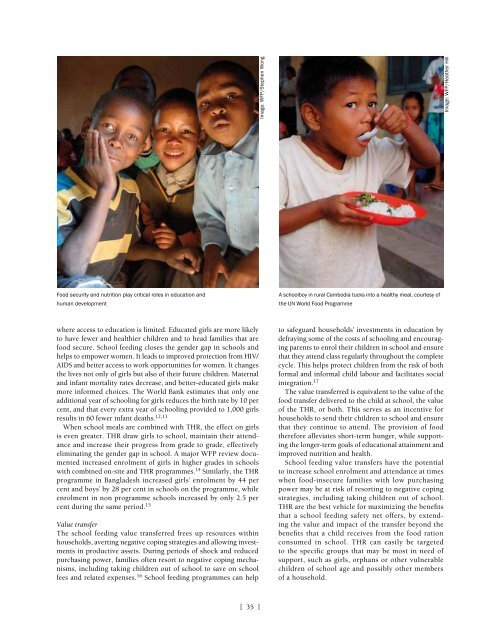Tomorrow today; 2010 - unesdoc - Unesco
Tomorrow today; 2010 - unesdoc - Unesco
Tomorrow today; 2010 - unesdoc - Unesco
Create successful ePaper yourself
Turn your PDF publications into a flip-book with our unique Google optimized e-Paper software.
Image: WFP/Stephen WongImage: WFP/Heather HillFood security and nutrition play critical roles in education andhuman developmentA schoolboy in rural Cambodia tucks into a healthy meal, courtesy ofthe UN World Food Programmewhere access to education is limited. Educated girls are more likelyto have fewer and healthier children and to head families that arefood secure. School feeding closes the gender gap in schools andhelps to empower women. It leads to improved protection from HIV/AIDS and better access to work opportunities for women. It changesthe lives not only of girls but also of their future children. Maternaland infant mortality rates decrease, and better-educated girls makemore informed choices. The World Bank estimates that only oneadditional year of schooling for girls reduces the birth rate by 10 percent, and that every extra year of schooling provided to 1,000 girlsresults in 60 fewer infant deaths. 12,13When school meals are combined with THR, the effect on girlsis even greater. THR draw girls to school, maintain their attendanceand increase their progress from grade to grade, effectivelyeliminating the gender gap in school. A major WFP review documentedincreased enrolment of girls in higher grades in schoolswith combined on-site and THR programmes. 14 Similarly, the THRprogramme in Bangladesh increased girls’ enrolment by 44 percent and boys’ by 28 per cent in schools on the programme, whileenrolment in non programme schools increased by only 2.5 percent during the same period. 15Value transferThe school feeding value transferred frees up resources withinhouseholds, averting negative coping strategies and allowing investmentsin productive assets. During periods of shock and reducedpurchasing power, families often resort to negative coping mechanisms,including taking children out of school to save on schoolfees and related expenses. 16 School feeding programmes can helpto safeguard households’ investments in education bydefraying some of the costs of schooling and encouragingparents to enrol their children in school and ensurethat they attend class regularly throughout the completecycle. This helps protect children from the risk of bothformal and informal child labour and facilitates socialintegration. 17The value transferred is equivalent to the value of thefood transfer delivered to the child at school, the valueof the THR, or both. This serves as an incentive forhouseholds to send their children to school and ensurethat they continue to attend. The provision of foodtherefore alleviates short-term hunger, while supportingthe longer-term goals of educational attainment andimproved nutrition and health.School feeding value transfers have the potentialto increase school enrolment and attendance at timeswhen food-insecure families with low purchasingpower may be at risk of resorting to negative copingstrategies, including taking children out of school.THR are the best vehicle for maximizing the benefitsthat a school feeding safety net offers, by extendingthe value and impact of the transfer beyond thebenefits that a child receives from the food rationconsumed in school. THR can easily be targetedto the specific groups that may be most in need ofsupport, such as girls, orphans or other vulnerablechildren of school age and possibly other membersof a household.[ 35 ]

















